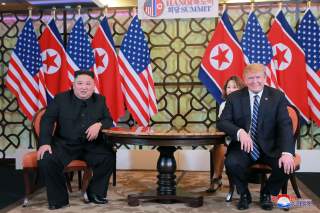The Hanoi Summit – We Asked Harry J. Kazianis What Happens Next in U.S.-North Korea Relations
"Trump should unleash South Korea’s President Moon Jae-in, the only person who understands on an intimate level both leaders’ goals."
Editor’s Note: Looking for more opinions on where we go after the Hanoi summit? Check out all 80 expert takes on where U.S-North Korea relations go next here.
After events in Hanoi, we have reached that all too familiar fork in the road with North Korea.
The good news for the Trump Administration is that, by and large, Washington controls its own destiny on this issue, with many open avenues to secure a Korean Peninsula that is free from war while securing our allies and our own national interest.
Here, as I see it, is a quick rundown of where we could head next:
1. Trump Uses North Korea To His Advantage, And We Have Trouble: We can’t discount the fact that president Trump, seeing no upside to a so-called “small deal” with North Korean chairman Kim Jong-un, decided his only strategy was to “go big” or go home—literally.
Trump may have calculated that an interim deal would be attacked by neoconservatives and Democrats alike as being some form of appeasement, so he either needed a big “win” or needed to walk to show strength.
If that is the case, and I suspect it is, the administration will double down on a hardline approach, giving no ground whatsoever, feeling there is no upside politically in doing so. And in fact, North Korea Special Representative Stephen Biegen seemed to do just that in remarks here in Washington, D.C. just recently on March 11. If this is indeed the case, Pyongyang will most surely disengage from the current negotiations and mimic Washington’s hardline in its own way. Where this goes is anyone’s guess.
2. Trump Goes Back to “Fire and Fury”: Feeling boxed in domestically, the president decides to shift the news cycle's attention from things like the Mueller investigation to North Korea’s growing nuclear weapons arsenal. He could, for example, follow the same pattern of 2017 and make veiled threats against the north, restart large-scale U.S.-South Korea military exercises and go back to shows of strength like sending multiple aircraft carrier battle groups to the region. North Korea would most certainly respond, and we go back to the dark days of 2017, all over again.
3. Back to “Strategic Patience,” Sort of: Trump could just throw in the towel and decide to focus his foreign policy energies on Iran or Venezuela. The administration won’t waver from its CVID/FFID fantasies, with North Korea digging in its heels as well and refusing to negotiate. In such a scenario, Kim decides to hold off on any nuclear or missile testing until Trump leaves office, ensuring tensions don’t spike while Pyongyang builds up already-proven nuclear warhead and missile designs.
4. Trump Goes “Big,” And Builds Trust: Want to get the North Koreans to give up their nukes—or at least have a chance at convincing them? How about trying to build some trust by doing things like ending the Korean War with a peace declaration and opening liaison offices? That would show Kim that Trump is committed to transforming relations—and not just getting ahold of Pyongyang’s nukes.
Also, while we are at it, Trump should unleash South Korea’s President Moon Jae-in, the only person who understands on an intimate level both leaders’ goals. Trump should green light any and all inter-Korean economic development projects as a way to coax Kim to the bargaining table, potentially trading these projects for conventional arms control initiatives along the Demilitarized Zone.
Harry J. Kazianis is director of Korean Studies at the Center for the National Interest. Follow him on Twitter @Grecianformula.
Image: Reuters

